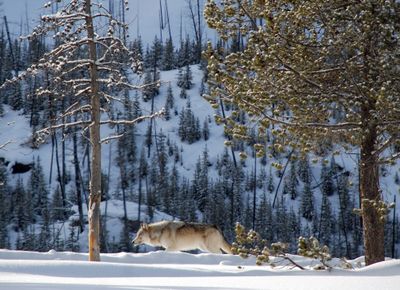Gray wolf population strong

BILLINGS – Federal officials say a record 1,645 gray wolves counted in the Northern Rockies this winter shows the predators’ population remains strong, but is no longer expanding as rapidly as in past years.
Since their reintroduction to the region in the mid-1990s, wolf numbers had previously grown on average by 24 percent annually in Wyoming, Idaho and Montana.
This year’s figure is up only 8 percent, said U.S. Fish and Wildlife Service biologist Ed Bangs.
Bangs says the slowdown – combined with increasing numbers of livestock killed by the animals – signals wolves have filled most prime habitat in the three states.
“The population is getting to about as many as you’re going to have,” he said. “There’s a big, healthy population in the Northern Rocky Mountains,” he said. “At some point, the suitable habitat will be filled with wolves and the population just won’t grow any more.”
The government’s annual winter wolf count found 497 of the predators in Montana, 302 in Wyoming and 846 in Idaho.
Livestock kills by wolves spiked more than 40 percent, with 601 cattle, sheep, llamas, dogs and other domestic animals killed.
In response government wildlife agents and ranchers killed 264 wolves last year, or about one of every six wolves in the entire population. That included 21 entire packs.
Wildlife Services – the division within the U.S. Department of Agriculture that removed most of those wolves – spent almost $1 million on its efforts. In total, $3.7 million was spent on wolf management in the region in 2008.
Federal officials in January declared the region’s wolves were ready to come off the endangered species list in Idaho and Montana. That decision was upheld by the Obama administration earlier this month – to the dismay of environmental and animal rights groups who contend that wolves need further protection.
Those groups have vowed to challenge that decision in court once it is published in the federal register. That could happen next week.
Removing endangered status for the animals would allow state wildlife agencies in Idaho and Montana to proceed with plans for public wolf hunts as soon as this fall.
Wolves in Wyoming will remain on the list. Wyoming Attorney General Bruce Salzburg has said he will likely challenge that exclusion in federal court.
Interior Secretary Ken Salazar has said Wyoming’s laws and regulations are not adequate to ensure the wolves’ continued survival. State officials want to turn almost 90 percent of Wyoming into a “predator zone” where wolves can be shot on sight.
Jonathan Lovvorn, vice president for the Humane Society of the United States, said laws in Idaho and Montana also offer too few protections.
“The problem has always been not so much this week’s news on wolf numbers, but what’s likely to happen to wolf numbers if they’re turned over to state management,” Lovvorn said. “We have our doubts about whether that (population growth) will continue.”